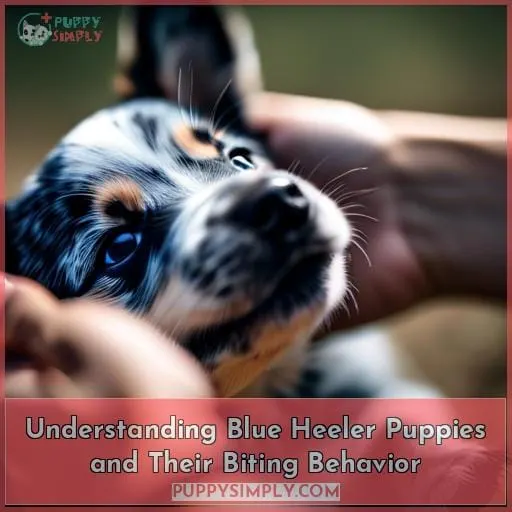This site is supported by our readers. We may earn a commission, at no cost to you, if you purchase through links.
 Imagine a playful pup, nipping at your heels, demanding your attention. That’s your Blue Heeler, an energetic herder with a biting habit.
Imagine a playful pup, nipping at your heels, demanding your attention. That’s your Blue Heeler, an energetic herder with a biting habit.
When will this end? Fear not, for we’ll guide you through the teething phase, explore their herding instincts, and teach you training techniques to curb biting.
Let’s embark on this journey to a harmonious relationship with your Blue Heeler.
Table Of Contents
- Key Takeaways
- Understanding Blue Heeler Puppies and Their Biting Behavior
- The Teething Phase: When It Starts and Ends
- Herding Instincts and Biting
- Training Techniques to Curb Biting
- When to Seek Professional Help
- Frequently Asked Questions (FAQs)
- How can I differentiate between normal puppy biting and aggressive behavior?
- Are there specific physical or behavioral changes in blue heeler puppies that indicate the onset of the teething phase?
- What are some creative and engaging activities that can be used to redirect biting behavior in blue heeler puppies?
- How can I ensure that my blue heeler puppy does not develop a habit of biting people and objects, even after the teething phase?
- Are there any underlying health conditions or developmental issues in blue heeler puppies that might contribute to excessive biting behavior?
- Conclusion
Key Takeaways
- Blue Heeler puppies generally stop biting around 6 months of age when their teething phase ends.
- Training techniques to curb biting include positive reinforcement, redirection, consistent discipline, time-outs, and socialization.
- If biting persists despite training, consider seeking professional help from a veterinarian, animal behaviorist, or qualified trainer.
- Professional intervention options range from positive reinforcement techniques to medication, tailored to the specific needs of the puppy.
Understanding Blue Heeler Puppies and Their Biting Behavior
- In understanding Blue Heeler puppies and their biting behavior, you’ll want to know that they tend to nip and chew as a natural part of their development.
- This behavior is often associated with teething, exploration, and play.
- As a responsible pet owner, it’s essential to recognize these underlying causes to effectively address the biting issue.
- Teething, in particular, can be a painful experience for puppies.
- Their gums become inflamed and gereirritated, leading them to seek relief by chewing on objects.
- Providing them with appropriate chew toys can help alleviate this discomfort and redirect their attention away from biting you or your belongings.
- Additionally, socialization techniques, consistent discipline, and pain management strategies can play a crucial role in curbingcurbing biting behavior.
The Teething Phase: When It Starts and Ends
You’ll notice your Blue Heeler puppy start teething around 8 weeks of age.
This process typically lasts until they’re about 6 months old.
During this time, you’ll observe several teething milestones, including the eruption of their baby teeth, followed by the shedding of these teeth and the emergence of their permanent adult teeth.
Behavioral changes often accompany teething.
Your puppy may become more irritable, chew on objects excessively, and exhibit increased biting.
These behaviors are their way of managing the discomfort and pain associated with teething.
Understanding these changes will help you respond with empathy and provide appropriate support.
Herding Instincts and Biting
Biting comes naturally to Blue Heelers due to their strong herding instincts. They instinctively use their mouth to control and move livestock.
This behavior can manifest as nipping, herding, or biting when interacting with people or other animals.
The herding instinct is particularly strong in puppies, which may exhibit mouthing and biting as a way to explore their environment and assert their dominance.
To prevent nipping and biting, it’s crucial to redirect your Blue Heeler’s herding instincts into appropriate behaviors.
Engage them in interactive play sessions, using toys and activities that encourage chasing, retrieving, or herding.
You can also incorporate bite inhibition training to teach your puppy to control the force of their bite.
Additionally, manage playtime to ensure your puppy doesn’t get overexcited and redirect their attention if they start to nip or bite.
Training Techniques to Curb Biting
With patience and consistency, you can utilize positive reinforcement training techniques to discourage your Blue Heeler puppy from biting.
Positive reinforcement rewards good behavior, strengthening the connection between desired actions and favorable outcomes.
When your puppy refrains from biting, offer praise, treats, and petting to reinforce the positive behavior.
Redirecting behavior is another effective technique.
When your puppy attempts to bite, immediately offer an appropriate chew toy or engage them in a different activity to divert their attention.
Consistent discipline is essential.
Establish clear boundaries and rules, and enforce them consistently.
Time-outs or brief periods of isolation can be effective consequences for biting.
Finally, socialization skills are crucial.
Expose your puppy to various people, animals, and environments to help them learn appropriate social behaviors and reduce the likelihood of biting out of fear or anxiety.
When to Seek Professional Help
Despite applying suitable training methods, if your Blue Heeler’s biting behavior persists and intensifies, consider seeking professional help.
A behavioral assessment by a veterinarian or a qualified animal behaviorist can pinpoint the underlying cause, whether it’s anxiety, fear, or a medical issue.
Veterinary consultation can rule out any health concerns contributing to the biting, while a trainer referral can connect you with experts skilled in behavioral modification.
Professional intervention options range from positive reinforcement techniques to medication, ensuring a tailored approach to curb your Blue Heeler’s biting and restore harmony in your household.
Frequently Asked Questions (FAQs)
How can I differentiate between normal puppy biting and aggressive behavior?
Examine the puppy’s body language:
Playful biting often includes a wagging tail and relaxed posture, while aggressive behavior may involve growling, stiffening, or baring teeth.
Are there specific physical or behavioral changes in blue heeler puppies that indicate the onset of the teething phase?
As your Blue Heeler puppy embarks on a teething odyssey,
subtle shifts in behavior may emerge like blooming petals.
Keep a keen eye for:
- Increased chewing,
- Swollen gums, and
- A heightened desire for companionship.
What are some creative and engaging activities that can be used to redirect biting behavior in blue heeler puppies?
Engage your blue heeler puppy’s natural instincts with interactive games:
- Fetch
- Tug-of-war
Hide treats around the house for a stimulating treasure hunt.
Enroll your pup in puppy socialization classes for:
- Positive interactions
- Bite inhibition training
How can I ensure that my blue heeler puppy does not develop a habit of biting people and objects, even after the teething phase?
Redirect unwanted biting behaviors in your blue heeler puppy with engaging activities like tug-of-war or fetch.
This strategy helps establish boundaries and reinforces positive interactions, reducing the likelihood of persistent biting habits.
Are there any underlying health conditions or developmental issues in blue heeler puppies that might contribute to excessive biting behavior?
Biting in blue heeler puppies may signal underlying health issues or developmental concerns.
Watch for signs of pain, discomfort, anxiety, or stress.
Consult a veterinarian or animal behaviorist for guidance and support.
Conclusion
You’ve embarked on a journey with your Blue Heeler.
While the nipping and biting may seem relentless, remember, it’s not forever.
With patience, training, and understanding, you’ll reach a harmonious relationship where your pup’s biting is a thing of the past.
So, embrace the journey and enjoy the companionship of your loyal and loving Blue Heeler.











